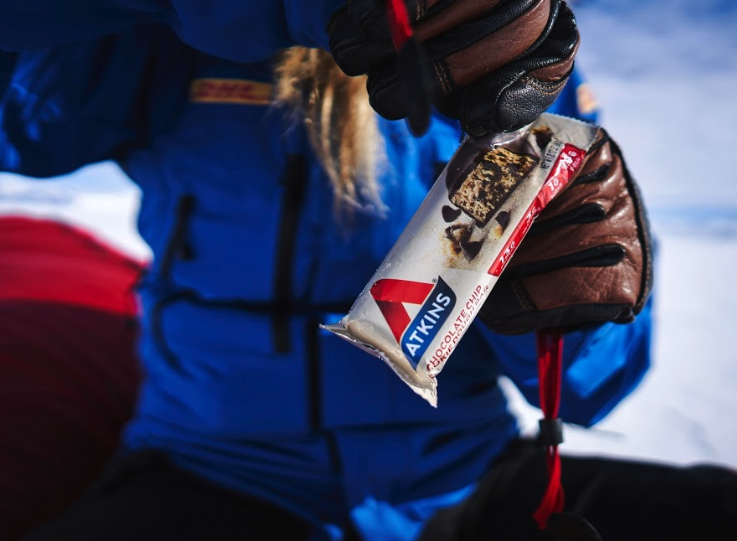Day Nineteen: 209 miles travelled, 506 miles remaining
After another day of minus 25 knot winds and lots more snow (argh!), I’m taking the time to answer a few questions on my nutrition for this expedition.
Nutrition has always been a key factor for me, starting from my preparation before Antarctica to this day, where I have to maintain the right diet to help keep energy levels up. As a low-carb athlete, that means I look to get the majority of my calories from fats and proteins. Traditionally runners would load up on carbohydrate before races but there is a growing body of athletes and scientists who think you can better manage your nutrition and health by reducing the carbohydrates in the diet.
There are certainly differences in everyone’s genetic makeup and metabolisms but this works well for me. I have been ‘low carb’ for a couple of years so I’m well adapted to the increased fat. Fat is the most calorie dense food type and therefore a great choice when you have to carry all of your food for a long duration. It also keeps me fuller for longer and avoids the sugar highs and lows. I’m still eating carbohydrates on this trip, just a lower percentage overall than most modern polar expeditions.
The ‘Atkins’ Diet was one of the earliest high protein and higher fat low carbohydrate diets and I am delighted to be working with Atkins, who have a range of delicious and low sugar snacks that I have with me on this trip.
As a professional athlete my diet is designed to give the body what it needs to remain strong during long workouts, here are a few reasons why:
- A low carb diet like Atkins helps your body burn fat instead of store it
- Eating fewer carbs allows your blood sugar levels to return to normal by limiting spikes from sugar intake. This controls insulin levels, helping your body burn more fat
- One of the best things about the Atkins diet is that it’s not about limiting how much you eat, but rather being smart about what you’re eating. This is key for professional athletes who need to continuously replenish their nutrients after burning them quickly in workouts
- Instead of loading up on foods that spike blood sugar levels, athletes will eat proteins that help stabilise their blood sugar and insulin levels like chicken, fish, pork and beef. They balance these proteins with healthy fats including nuts, avocados, olive oil and other vegetables. This low carb diet for athletes is designed to help their bodies operate in the way they need to perform their best
The early polar explorers ate pemmican, a high fat snack, as their lunch of choice and the indigenous Arctic populations traditionally eat a very high fat meat-based diet; history supports the low carb diet for polar travel.
A high carb diet locks an athlete into a dependence on glucose as the dominant fuel for exercise. It’s a fact that when we digest and absorb carbs as sugar, the body is forced to prioritise burning that sugar while simultaneously impairing access to and use of fat. Storage of sugar in the body as glycogen is limited to last about one day, or only a couple hours of high-intensity exercise. To prevent this small carb fuel tank from running dry, frequent ingestion of carbs is necessary to prevent a fuel crisis. The strategy of repeatedly shot-gunning sugar-laden gels and drinks to keep the carb furnace stoked is an approach used by many athletes, but it’s worth asking whether this is optimal, healthy, and sustainable. For many athletes, the answer is clearly no!
My day is broken up with a breakfast of a nut-based granola with high fat powdered milk and coffee obviously. Lunch is on the go as stopping just makes me cold so I will be snacking on my favourite Atkins bars, cheese, nuts and a powdered high fat protein shake made by Ample. Dinner is a dehydrated meal, I think I’ve already mentioned the Pad Thai!
Jenny Davis: Solo to the South Pole, Delivered by DHL is aiming to raise funds for Children in Need. To donate, click here or text ‘SPJD99 £3’ to 70070 to contribute £3.
Comment below for the chance to have Jenny answer your questions during her solo expedition to the South Pole.
